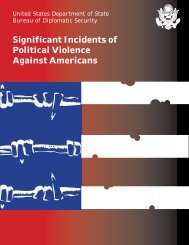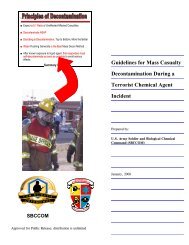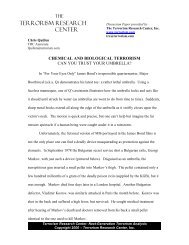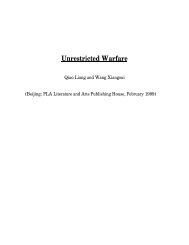Combating Proliferation of Weapons of Mass Destruction
Combating Proliferation of Weapons of Mass Destruction
Combating Proliferation of Weapons of Mass Destruction
You also want an ePaper? Increase the reach of your titles
YUMPU automatically turns print PDFs into web optimized ePapers that Google loves.
Finally, the law required the President to report to Congress in his fiscal year (FY) 1998budget on his specific plans for the comprehensive preparedness program, with budgetestimates by department and agency for FY 1998 and the following five years.As with the NSC Transnational Threats Committee, there is no information in the publicdomain to suggest that the NSC formed the <strong>Proliferation</strong> Committee, but it could be arguedthat the NSC Principals Committee performs the same function.Office <strong>of</strong> the Vice PresidentThe Vice President’s responsibility in U.S. proliferation-related activities is rooted in hisstatutory membership on the National Security Council, but his role derives from thesolicitation <strong>of</strong> his advice by the President and the specific tasking on national securitymatters given him by the President. The Vice President’s facility as an advisor on nationalsecurity affairs, including combating the proliferation <strong>of</strong> weapons <strong>of</strong> mass destruction,obviously depends on his personal chemistry with the President, as well as his ownbackground, diplomatic skills, and experience in these matters. From the outset <strong>of</strong> theClinton Administration, the President expressed confidence in the Vice President’s foreignpolicy knowledge and abilities, relied on him regularly for advice on key issues, andassigned him broad responsibilities and specific tasks, which included proliferation-relatedproblems.The Vice President’s national security affairs staff is composed <strong>of</strong> a National SecurityAdvisor, who is appointed by the Vice President and occupies a White House personnelposition; a Deputy National Security Advisor, also appointed by the Vice President anddetailed from a department or agency; six substantive specialists; and six supportpersonnel, also detailed from departments and agencies. Each substantive specialistmanages a portfolio <strong>of</strong> regional and functional issues, roughly paralleling the NSC seniordirector structure. Thus, the substantive specialist responsible for proliferation and exportcontrol issues may also cover other functional areas, such as Defense Policy and ArmsControl, and possibly a region as well. Given its extremely small size and the breadth <strong>of</strong> itsresponsibilities, the Vice President’s national security affairs staff must work very closelywith the NSC staff.The Vice President and his national security affairs staff become involved in U.S.proliferation-related activities through (1) the Vice President’s function <strong>of</strong> advising thePresident on national security issues, either informally or as a member <strong>of</strong> the President’sforeign policy team, and his participation in the President’s White House meetings withvisiting foreign leaders, (2) the Vice President’s own meetings and conversations withsenior foreign government <strong>of</strong>ficials, both in Washington and on <strong>of</strong>ficial travel abroad, (3)the binational commissions authorized by the President and co-chaired by the Vice14







